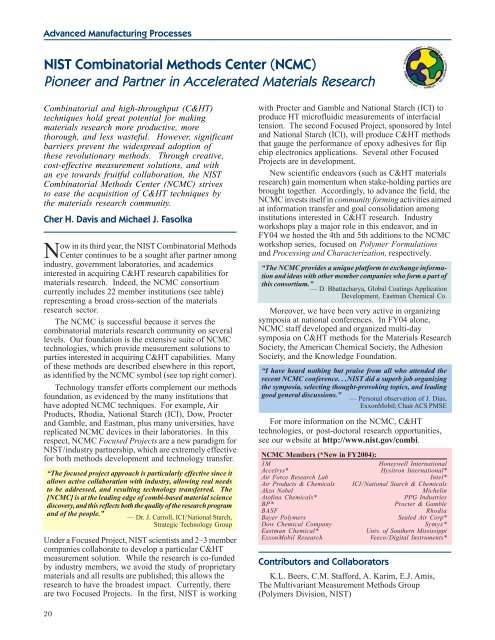Materials Science and Engineering Laboratory FY 2004 ... - NIST
Materials Science and Engineering Laboratory FY 2004 ... - NIST
Materials Science and Engineering Laboratory FY 2004 ... - NIST
Create successful ePaper yourself
Turn your PDF publications into a flip-book with our unique Google optimized e-Paper software.
Advanced Manufacturing Processes<br />
<strong>NIST</strong> Combinatorial Methods Center (NCMC)<br />
Pioneer <strong>and</strong> Partner in Accelerated <strong>Materials</strong> Research<br />
Combinatorial <strong>and</strong> high-throughput (C&HT)<br />
techniques hold great potential for making<br />
materials research more productive, more<br />
thorough, <strong>and</strong> less wasteful. However, significant<br />
barriers prevent the widespread adoption of<br />
these revolutionary methods. Through creative,<br />
cost-effective measurement solutions, <strong>and</strong> with<br />
an eye towards fruitful collaboration, the <strong>NIST</strong><br />
Combinatorial Methods Center (NCMC) strives<br />
to ease the acquisition of C&HT techniques by<br />
the materials research community.<br />
Cher H. Davis <strong>and</strong> Michael J. Fasolka<br />
Now in its third year, the <strong>NIST</strong> Combinatorial Methods<br />
Center continues to be a sought after partner among<br />
industry, government laboratories, <strong>and</strong> academics<br />
interested in acquiring C&HT research capabilities for<br />
materials research. Indeed, the NCMC consortium<br />
currently includes 22 member institutions (see table)<br />
representing a broad cross-section of the materials<br />
research sector.<br />
The NCMC is successful because it serves the<br />
combinatorial materials research community on several<br />
levels. Our foundation is the extensive suite of NCMC<br />
technologies, which provide measurement solutions to<br />
parties interested in acquiring C&HT capabilities. Many<br />
of these methods are described elsewhere in this report,<br />
as identified by the NCMC symbol (see top right corner).<br />
Technology transfer efforts complement our methods<br />
foundation, as evidenced by the many institutions that<br />
have adopted NCMC techniques. For example, Air<br />
Products, Rhodia, National Starch (ICI), Dow, Procter<br />
<strong>and</strong> Gamble, <strong>and</strong> Eastman, plus many universities, have<br />
replicated NCMC devices in their laboratories. In this<br />
respect, NCMC Focused Projects are a new paradigm for<br />
<strong>NIST</strong>/industry partnership, which are extremely effective<br />
for both methods development <strong>and</strong> technology transfer.<br />
“The focused project approach is particularly effective since it<br />
allows active collaboration with industry, allowing real needs<br />
to be addressed, <strong>and</strong> resulting technology transferred. The<br />
[NCMC] is at the leading edge of combi-based material science<br />
discovery, <strong>and</strong> this reflects both the quality of the research program<br />
<strong>and</strong> of the people.”<br />
— Dr. J. Carroll, ICI/National Starch,<br />
Strategic Technology Group<br />
Under a Focused Project, <strong>NIST</strong> scientists <strong>and</strong> 2–3 member<br />
companies collaborate to develop a particular C&HT<br />
measurement solution. While the research is co-funded<br />
by industry members, we avoid the study of proprietary<br />
materials <strong>and</strong> all results are published; this allows the<br />
research to have the broadest impact. Currently, there<br />
are two Focused Projects. In the first, <strong>NIST</strong> is working<br />
20<br />
with Procter <strong>and</strong> Gamble <strong>and</strong> National Starch (ICI) to<br />
produce HT microfluidic measurements of interfacial<br />
tension. The second Focused Project, sponsored by Intel<br />
<strong>and</strong> National Starch (ICI), will produce C&HT methods<br />
that gauge the performance of epoxy adhesives for flip<br />
chip electronics applications. Several other Focused<br />
Projects are in development.<br />
New scientific endeavors (such as C&HT materials<br />
research) gain momentum when stake-holding parties are<br />
brought together. Accordingly, to advance the field, the<br />
NCMC invests itself in community forming activities aimed<br />
at information transfer <strong>and</strong> goal consolidation among<br />
institutions interested in C&HT research. Industry<br />
workshops play a major role in this endeavor, <strong>and</strong> in<br />
<strong>FY</strong>04 we hosted the 4th <strong>and</strong> 5th additions to the NCMC<br />
workshop series, focused on Polymer Formulations<br />
<strong>and</strong> Processing <strong>and</strong> Characterization, respectively.<br />
“The NCMC provides a unique platform to exchange information<br />
<strong>and</strong> ideas with other member companies who form a part of<br />
this consortium.” — D. Bhattacharya, Global Coatings Application<br />
Development, Eastman Chemical Co.<br />
Moreover, we have been very active in organizing<br />
symposia at national conferences. In <strong>FY</strong>04 alone,<br />
NCMC staff developed <strong>and</strong> organized multi-day<br />
symposia on C&HT methods for the <strong>Materials</strong> Research<br />
Society, the American Chemical Society, the Adhesion<br />
Society, <strong>and</strong> the Knowledge Foundation.<br />
“I have heard nothing but praise from all who attended the<br />
recent NCMC conference. . .<strong>NIST</strong> did a superb job organizing<br />
the symposia, selecting thought-provoking topics, <strong>and</strong> leading<br />
good general discussions.” — Personal observation of J. Dias,<br />
ExxonMobil; Chair ACS PMSE<br />
For more information on the NCMC, C&HT<br />
technologies, or post-doctoral research opportunities,<br />
see our website at http://www.nist.gov/combi.<br />
NCMC Members (*New in <strong>FY</strong><strong>2004</strong>):<br />
3M Honeywell International<br />
Accelrys* Hysitron International*<br />
Air Force Research Lab Intel*<br />
Air Products & Chemicals ICI/National Starch & Chemicals<br />
Akzo Nobel Michelin<br />
Atofina Chemicals* PPG Industries<br />
BP* Procter & Gamble<br />
BASF Rhodia<br />
Bayer Polymers Sealed Air Corp*<br />
Dow Chemical Company Symyx*<br />
Eastman Chemical* Univ. of Southern Mississippi<br />
ExxonMobil Research Veeco/Digital Instruments*<br />
Contributors <strong>and</strong> Collaborators<br />
K.L. Beers, C.M. Stafford, A. Karim, E.J. Amis,<br />
The Multivariant Measurement Methods Group<br />
(Polymers Division, <strong>NIST</strong>)

















